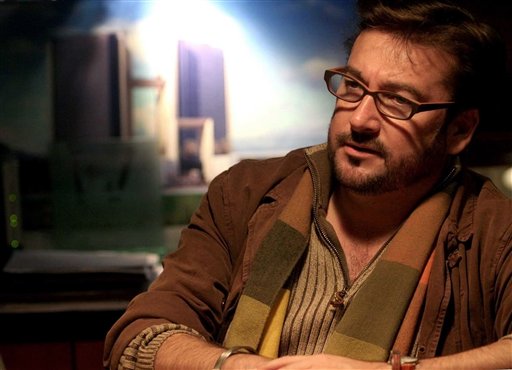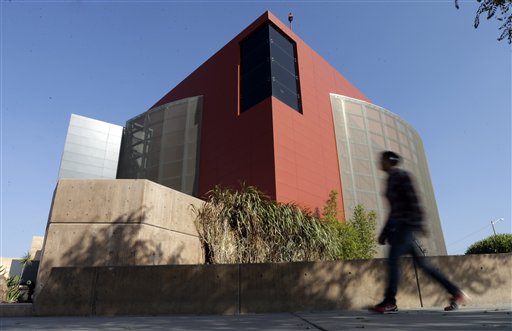SAN DIEGO — A highly acclaimed architect was sentenced Monday to six months in prison for trying to enter the U.S. with nearly 13 pounds of cocaine hidden in his minivan’s battery.
A federal judge ordered the unusually light punishment after Eugenio Velazquez claimed drug traffickers threatened to kill him if he refused to carry drugs for them.
Velazquez, a dual citizen of the U.S. and Mexico who lives in suburban San Diego, had a distinguished 30-year career in Mexico designing some of Tijuana’s most prominent buildings, including its new main cathedral, an expansion of the Tijuana Cultural Center, and police headquarters.
The San Diego native embraced his smiling wife, daughters and supporters outside court after being told to report to prison Jan. 11 to begin the sentence in federal custody, followed by six more months of home confinement.
“I’m very satisfied,” a beaming Velazquez told reporters. “I’m at peace with myself.”
Velazquez pleaded guilty in June to trying to bring 12.8 pounds of cocaine into the U.S. in a special lane for prescreened, trusted motorists. A drug-sniffing dog alerted inspectors to five packages hidden in the battery of his 2004 Nissan Quest at San Diego’s San Ysidro port of entry.
Velazquez faced a minimum mandatory sentence of 10 years for importing a controlled substance, but his lack of a criminal record and other factors gave the judge discretion to deliver the more lenient punishment.
Prosecutors asked for 2½ years in prison in a brief court filing but made no argument after U.S. District Judge Thomas Whelan signaled he was leaning toward the lighter sentence. Velazquez’s attorney, Jeremy, Warren, had asked for one year of home confinement.
The judge said the ability of Velazquez to verify threats against him were crucial to the reduced sentence. He was also acknowledged for leading “a good life” until his arrest.
A court filing by his attorney said Velazquez’s downfall began with a project to design the facade of a ranch.
The architect, fearful of drug-fueled violence in Tijuana, accepted his client’s offer to provide personal security while Velazquez crossed the border between home and work.
The arrangement seemed to work out so well that Velazquez referred a friend who also wanted protection.
Then the client — unnamed in the filing — demanded the men pay $40,000 or drive drugs across the border. He flipped a coin to determine who would transport the drugs and Velazquez lost. The architect surrendered his minivan for packing and got the call to move the cocaine on March 4, his wife’s birthday.
Velazquez’s attorney told reporters after the sentencing that the friend verified the claims for U.S. investigators. Both men said they were threatened at gunpoint.
“This does happen but it’s extremely difficult to convince anybody,” Warren said.
As Mexican cartels move cocaine north from South America, they rely on “mules” to hide small packages of drugs in vehicle compartments and on their bodies to get past U.S. inspectors on the Mexico border. Many couriers are young, poor or adrift, desperate for a few hundred dollars.
At California crossings alone, inspectors seized 86 tons of marijuana, 7 tons of cocaine and 4 tons of methamphetamine in the 2011 fiscal year.
Velazquez, a college professor and devoted Catholic, has done more than 400 residential, commercial and liturgical projects during a 30-year career. His work ranges from utilitarian industrial parks for multinational corporations on Tijuana’s eastern outskirts to some of the city’s most recognized landmarks.
Zeta, a Tijuana newspaper known for investigating organized crime, named Velazquez its cultural person of the year in 2008. That same year, the Tijuana Cultural Center opened “El Cubo,” or “The Cube,” his $9-million, burnt-sienna structure that stands next to a distinctive globe-shaped building and provides enough space for large art exhibitions.
After being freed on $100,000 bond after his arrest, Velazquez opened an architecture and interior design firm with a friend in Chula Vista, a San Diego suburb.
Velazquez said Monday he would press ahead with Tijuana’s Our Lady of Guadalupe Cathedral, a giant complex under construction across the street from City Hall that will be the seat of the Catholic archdiocese.
Send questions/comments to the editors.




Success. Please wait for the page to reload. If the page does not reload within 5 seconds, please refresh the page.
Enter your email and password to access comments.
Hi, to comment on stories you must . This profile is in addition to your subscription and website login.
Already have a commenting profile? .
Invalid username/password.
Please check your email to confirm and complete your registration.
Only subscribers are eligible to post comments. Please subscribe or login first for digital access. Here’s why.
Use the form below to reset your password. When you've submitted your account email, we will send an email with a reset code.